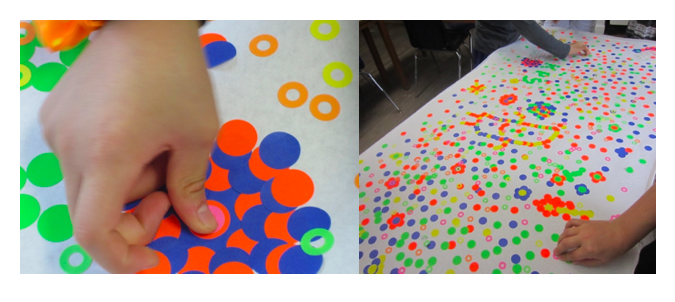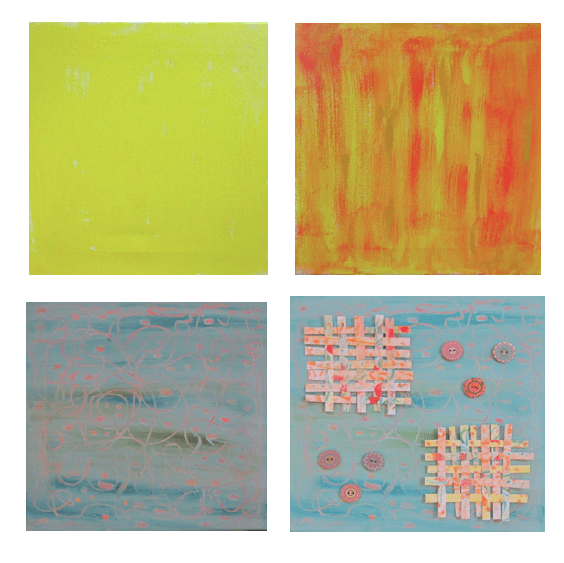In his latest post, “A Crowd of Me,” Mario Perron writes about the process of beginning a new painting:
Staring at the big (30″ x 30″), white canvas is often the most stressful part of my process. How do I start? Where do I start? That very first mark is so important to me that I find myself in a battle against my fears and insecurities. A multitude of voices clamour for dominance in my head… It’s the same every time! I hear the light-speed and intensely elaborate debate between overthought and instinct, then my hand rises to the canvas and the first mark is there. When I let my mind go, the entire image starts to come into view in my imaginations and muscle-memory does the rest for guiding my hands.
This got me thinking of my own process of creating. I think a blank anything whether it is a canvas, paper, or piece of cloth – gives the artist a moment to ponder and stress. Something about the purity of the whiteness maybe. We don’t want to put something down that is wrong, ugly, or unintended. We want the marks, whether words, a painted image, or a quilted line, to be beautiful and meaningful and what we envisioned in our minds in the first place. With writing, the blank page is not so daunting to me. I create ideas in my head for a good long time, I let them percolate, and then I start placing them on the page. I’ve been doing this for about sixty years, so with practice comes familiarity and a kind of easy flow. With canvas or cloth, I am more hesitant. These I’ve done sporadically over the years; these hold more anxiety for me. It’s harder to undo a stitch or a painted line. Typing can be easily deleted, no one will ever know those awkward, ugly, simplistic words were ever there. But the painted or stitched line is harder to remove. There is evidence of my lack of ability permanently cast. So I wonder how to get beyond that. Abstraction and collage help. Making abstract images helps free my mind and in doing so it frees my hand. I don’t worry as much about perfection. I can just flow with the rhythm of what I’m feeling in that moment.


Abstraction helps me get in touch with the child inside. The young child, who hasn’t yet been touched by judgement. Peter Reynold’s picture book, The Dot, addresses this idea of self-judgement. In the story a young girl faces desire, hesitation, and ultimate success in making her artistic mark on the world. It’s a wonderful book about creativity and being brave making your mark. When I do creativity exercises with children, I change the blank paper into a paper with a dot or mark or hole in it. The paper already has an “imperfection.” Now they don’t have to worry about the first mark, it is already there. I challenge them to take that mark and use their imagination to create a design, image, or story. Young children don’t hesitate – they take up the challenge and just draw. Another activity I’ve done with students after reading Reynold’s book is to have them work together to create a mural using colorful self-sticking dots and. It is wonderful to see that there was a time we didn’t self-edit.


I often take an art mistake and incorporate it into a collage. A couple of months ago, I began dabbling again with watercolors. What was in my mind did not translate to the page. I was disappointed. I looked at the work again and decided I loved the colors, but not the image, so I cut the image into strips and woven them together into two squares. I liked how the watercolor was transformed and put it a way to use in a collage. This week, I took a twelve-inch square canvas, painted an undercoat of lemon yellow, yellow ochre, and vermillion. After that layer dried, I added a coat of green (a mixture of white, sap green and viridian). While that coat was still wet, I drew on top of that layer with rubber shaping tools creating a design of swirls and dots. I let my hand move freely and added bits of flourish as I saw fit. I let that layer dry and then placed my collage objects: the two woven watercolor squares and six wooden hand-painted buttons. I spent some time assembling and dissembling until I like the composition. Then I will permanently attach the pieces by sewing the into place of the canvas.

Instead of focusing on purity, I focus on possibility. It’s not important to me if the strips are the same width or that the weaving is not perfectly straight. To me, these imperfections make the work more interesting. What is beyond the canvas, page, cloth that I can imagine into being? How can I express what I’m thinking and feeling? How can I connect?

Picture Books That Stimulate the Imagination
Twenty Books and More that Join Crockett Johnson’s Harold and the Purple Crayon Creative Tradition:
- A Little Bit of Oomph! by Barney Saltzberg
- Also an Octopus by Maggie Tokuda-Hall
- Art by Patrick Mc Donnell
- Beautiful Oops! by Barney Saltzberg
- David Wiesner Books: Art & Max, Flotsam, Free Fall, June 29, 199, Tuesday…
- Du Iz Tak? by Carson Ellis
- How to by Julie Morstad
- Hum & Swish by Matt Myers
- Journey by Aaron Becker
- Lift by Minh Le and Dan Santat
- Max’s Castle by Kate Banks and Boris Kulikov
- Niko Draws a Feeling by Bob Raczka
- Not a Box by Antoinette Portis
- Not a Stick by Antoinette Portis
- Perfect Square by Michael Hall
- Peter H. Reynolds Books: The Dot, Ish, Skycolor, Happy Dreamer…
- The Artist Who Painted a Blue Horse by Eric Carle
- The Book of Mistakes by Corinna Luyken
- What if? by Samantha Berger
- Windblown by Edouard Mancea

Thanks for the ideas. I’m sending a couple along to my granddaughter who is on virtual school (6th grade) and loves doing art at the end of her school day.
LikeLiked by 1 person
Focusing on possibility. That’s what I need to keep front and center. I love your exploration into creating.
LikeLiked by 1 person
Oh man does this post make me want to try some exploring with collage. This line so resonated with me, “typing can be easily deleted, no one will ever know those awkward, ugly, simplistic words were ever there.” exactly why writing can be so easily explored today… love your writing so much…when things open up, I want to explore some classes… I wonder if anyone teaches collage. XO
LikeLiked by 1 person
Nanc, if you’re interested in collage, check out Laura Horn. She had some free and reasonably priced classes on collage on her website, laurahornart.com. You might find something you like there. Good luck!
LikeLike
This post is so dense with ideas. The dots; I especially like the crumpled up paper with the smooth black dots. There is something about the contrast and simple palette that draw me in. Mistakes finding homes within collages. And then a list of picture books, which is always a win with me.
LikeLiked by 1 person
What an inspiring post! I’ve been playing with magazine collage lately, but I love the idea of collage on canvas and building elements on it with weaving paper. Thanks for sharing the process.
LikeLike
Thank you, Nanc! There’s actually online collage classes. This is one I found –
https://www.carlasonheim.com/online-classes/the-joy-of-collage/
LikeLiked by 1 person
looking it up right now…thank you so much!
LikeLike
When I started reading your piece, I immediately thought of Peter Reynold’s book – Ish. Then, as I read on, I realized that you did too.
LikeLiked by 1 person
I share your trepidation with creating art when staring at the blank canvas. The page for me, like you, isn’t so scary, but the canvas, that’s a different story. Thank you for sharing your advice. And The Dot is such a great book! I love all his stories. 🙂
LikeLiked by 1 person
I can identify with your fear of canvas and cloth. I think we need to uncover our inner child and embrace our playful selves. Interesting to read your creation process. And I love the booklist!
LikeLike
I always love what you say about art and definitely this spirit of play. That question at the end is so important–“How can I connect?”
LikeLike
“I focus on possibility.”
So much good here every time!
LikeLike